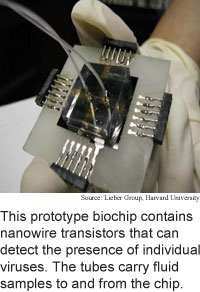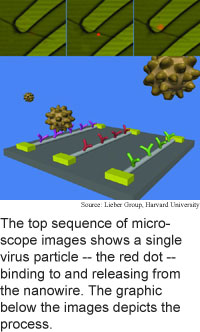
Biochip spots single viruses
By
Eric Smalley,
Technology Research NewsEnvironmental sensors and handheld devices that quickly and easily detect and identify individual viruses would provide early warning of infections in individuals, the spread of disease in populations, and biological weapons attacks.
The rapid development of nanotechnology in recent years has given researchers tools for building highly sensitive virus detectors. A team from Harvard University has built a detector from nanowires transistors that can identify individual virus particles in real time in unpurified samples.
The researchers' prototype uses antibody proteins attached to the nanowires to briefly capture individual virus particles. "The binding causes a change in the current of the nanowire-based electronic device, which signals the virus presence," said Charles Lieber, a professor of chemistry at Harvard University.
Labs-on-a-chip that are based on the device could be used to monitor diseases, said Lieber. For example, the AIDS virus, like other viruses, begins to duplicate itself after it enters a cell, he said. "If [these additional pathogens] can be spotted and treated by drugs before they overwhelm the body's immune system, there is less likelihood that the infection will turn into full-blown AIDS."
The device could also be used to study how viruses bind to receptors by determining which viruses bind to which receptors, how long virus particles bind to receptors, and what substances block or disrupt binding, Lieber said. The device could also eventually be used to detect individual biomolecules, including DNA and proteins, he said.
The researchers made their prototype by growing 20-nanometer-diameter silicon nanowires, mixing the nanowires with fluid, and flowing them into position across nickel contacts spaced two microns apart to form nanowire transistors. They coated the nanowires with aldehyde, then added antibody proteins, which adhered to the aldehyde. They configured a microfluidic channel to flow fluid containing the viruses across the nanowire sensors.
When an individual virus binds to a nanowire transistor antibody receptor, the transistor's electrical conductance changes, increasing or decreasing depending on whether the transistor carries positive or negative charge and the virus is positively or negatively charged. "Our detection method is based on a pure electrical detection of selective binding-unbinding of a single viral particle," said Lieber.
The researchers found that the duration of the bind-and-release cycle depends on the density of the antibody proteins on the nanowires. The cycle averaged just over one second at a low concentration of antibody proteins, about 20 seconds at a moderate density, and 5 to 10 minutes at a high density.
The researchers attached antibody proteins that bind to influenza A to one portion of the nanowire array and antibody proteins that bind to adenovirus to another portion and demonstrated that they can detect simultaneous binding of the two different types of viruses. "These nanowire detectors... could be scaled easily to enable sensing thousands of different viruses simultaneously," said Lieber.
Researchers have been able to detect individual virus particles in the laboratory for years using optical microscopes, but these approaches require purifying the samples and labeling the viruses with fluorescent markers, which makes them inappropriate for clinical and field diagnostics, said Lieber. They are also not able to detect viruses in samples with very low virus concentrations or detect multiple types of viruses, he said.
In recent years, researchers have also developed methods of detecting viruses using nanowire-and nanotube-based transistors, but these approaches involve processing purified samples to break down virus particles so that the virus DNA can bind to receptors on the devices.
Another technique that has emerged recently is detecting individual virus particles using microscopic cantilevers coated with antibody receptors. The additional mass of an attached virus particle changes the vibration rate of the cantilever, which can be detected electrically. These techniques require high-resolution imaging to confirm that only one virus particle has attached to the cantilever, however, said Lieber.
The researchers' next step is scaling up the nanowire transistor device, said Lieber. "We are working on a larger detector array, one that could sense up to 100 different viruses simultaneously," he said.
The researchers' sensor arrays could be used practically in two to five years, said Lieber.
Lieber's research colleagues were Fernando Patolsky, Gengfeng Zheng, Oliver Hayden, Melike Lakadamyali, and Xiaowei Zhuang. The work appeared in the September 13, 2004 issue of the Proceedings of the National Association of Science. The research was funded by the Defense Advanced Research Projects Agency (DARPA), the National Cancer Institute, the Ellison Medical Foundation, the Office of Naval Research, and the Searle Scholar Program.
Timeline: 2-5 years
Funding: Government, Private
TRN Categories: Sensors; Biotechnology; Nanotechnology
Story Type: News
Related Elements: Technical paper, "Electrical Detection of Single Viruses," Proceedings of the National Association of Sciences, September 13, 2004
Advertisements:
October 20/27, 2004
Page One
Biochip spots single viruses
Cooler material boosts fuel cells
Pen stroke cuts PDA Web clutter
Wide laser makes simple tweezers
Briefs:
Biochip levitates droplets
Nanotubes form transparent film
Molecules positioned on silicon
Mechanical valve design goes nano
Angles increase optical storage
Crystal links ultraviolet photons


News:
Research News Roundup
Research Watch blog
Features:
View from the High Ground Q&A
How It Works
RSS Feeds:
News
Ad links:
Buy an ad link
| Advertisements:
|
 |
Ad links: Clear History
Buy an ad link
|
TRN
Newswire and Headline Feeds for Web sites
|
© Copyright Technology Research News, LLC 2000-2006. All rights reserved.